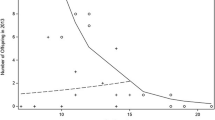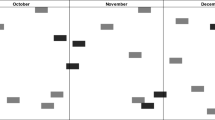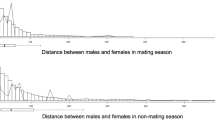Abstract
Male mating activities in relation to the likelihood of ovulation and conception were studied in a large group of semifree-ranging Barbary macaques (Macaca sylvanus) during two successive mating seasons. In both mating seasons, adult males attained a significantly higher mating success than subadult males, and they monopolized high ranking females more effectively than low ranking females during the period when conception was most probable. Also, in both mating seasons male rank was significantly correlated with male mating success if all sexually mature males were included. Nevertheless, mating success was not a linear function of age or rank. In both mating seasons mating success of 5-year-old males was much higher than that of dominant but peripheralized 6- and 7-year-old males. Moreover, a significant correlation between rank and measures of mating success among adult males was found in the second but not in the first mating season. The results indicate that mating and, most probably, reproductive success of male Barbary macaques is dependent on the male's social position in the group, which is defined not only by the outcome of dyadic agonistic encounters but also by the ability to get a central position in the group, and on the stability of rank relations.
Similar content being viewed by others
References
Bartecki, U., 1986. The social position of male Barbary macaques (Macaca sylvanus) in a semifree-ranging population.Primates, 27: 173–183.
Bercovitch, F. B., 1986. Male rank and reproductive activity in savanna baboons.Int. J. Primatol., 7: 533–550.
Berenstain, L. &T. D. Wade, 1983. Intrasexual selection and male mating strategies in baboons and macaques.Int. J. Primatol., 4: 201–235.
Carpenter, C. R., 1942. Sexual behavior of free-ranging rhesus monkeys (Macaca mulatta).J. Comp. Psychol., 33: 113–162.
Catchpole, H. R. &G. van Wagenen, 1978. Reproduction in the rhesus monkey,Macaca mulatta. In:The Rhesus Monkey, Vol. 1,G. H. Bourne (ed.), Academic Press, New York, pp. 117–140.
Chapais, B., 1983. Reproductive activity in relation to male dominance and the likelihood of ovulation in rhesus monkeys.Behav. Ecol. Sociobiol., 12: 215–228.
Conaway, C. H. &C. B. Koford, 1964. Estrous cycles and mating behavior in a free ranging band of rhesus monkeys.J. Mammal., 45: 577–588.
Curie-Cohen, M., D. Yoshihara, L. Luttrell, K. Benforado, J. W. MacCluer, &W. H. Stone, 1983. The effects of dominance on mating behavior and paternity in a captive troop of rhesus monkeys (Macaca mulatta).Amer. J. Primatol., 5: 127–138.
de Waal, F. B. M., 1987. Dynamics of social relationships. In:Primate Societies,B. B. Smuts,D. L. Cheney,R. M. Seyfarth,R. W. Wrangham, &T. T. Struhsaker (eds.), The Univ. of Chicago Press, Chicago & London, pp. 421–429.
Drickamer, L. C., 1974. A ten-year summary of reproductive data for free-rangingMacaca mulatta.Folia Primatol., 21: 61–90.
Duvall, S. W., I. S. Bernstein, &T. P. Gordon, 1976. Paternity and status in a rhesus monkey group.J. Reprod. Fertil., 47: 25–31.
Fedigan, L. M., 1983. Dominance and reproductive success in primates.Yb. Phys. Anthropol., 26: 85–123.
————,L. Fedigan, S. Gouzoules, H. Gouzoules, &N. Koyama, 1986. Lifetime reproductive success in female Japanese macaques.Folia Primatol., 47: 143–157.
Glick, B. B., 1980. Ontogenetic and psychological aspects of the mating activities of maleMacaca radiata. In:The Macaques. Studies in Ecology, Behavior and Evolution,D. G. Lindburg (ed.), Van Nostrand Reinhold, New York, pp. 345–369.
Gouzoules, S., H. Gouzoules, &P. Marler, 1984. Rhesus monkey (Macaca mulatta) screams: Representational signalling in the recruitment of agonistic aid.Anim. Behav., 32: 182–193.
Hausfater, G., 1975.Dominance and Reproduction in Baboons (Papio cynocephalus). Contributions to Primatology, Vol. 7, S. Karger, Basel.
Kaumanns, W., 1978. Berberaffen (Macaca sylvana) im Freigehege Salem.Z. Kölner Zoo, 21: 57–66.
Kuester, J. &A. Paul, 1984. Female reproductive characteristics in semifree-ranging Barbary macaques (Macaca sylvanus L. 1758).Folia Primatol., 43: 69–83.
———— & ————, 1989. Reproductive strategies of sub-adult Barbary macaque males at Affenberg Salem. In:Sociobiology of Reproductive Strategies in Animals and Humans,O. A. E. Rasa,C. Vogel, &E. Voland (eds.), Chapman & Hall, London, pp. 93–109.
Kummer, H., W. Götz, &W. Angst, 1974. Triadic differentiation: An inhibitory process protecting pair bonds in baboons.Behaviour, 49: 62–87.
Lindburg, D. G., 1971. The rhesus monkey in North India: An ecological and behavioral study. In:Primate Behavior. Development in Field and Laboratory Research, Vol. 2,L. A. Rosenblum (ed.), Academic Press, New York, pp. 1–106.
————, 1983. Mating behavior and estrus in the Indian rhesus monkey. In:Perspectives in Primate Biology,P. K. Seth (ed.), Today & Tomorrow's Printers and Publishers, New Delhi, pp. 45–61.
Loy, J., 1971. Estrous behavior of free-ranging rhesus monkeys.Primates, 12: 1–31.
McMillan, C. A., 1982. Dominance, adult-subadult status and male mating success in rhesus monkeys.Amer. J. Phys. Anthropol., 57: 207.
————, 1986. Lineage-specific mating: Does it exist? In:The Cayo Santiago Macaques. History, Behavior and Biology,R. G. Rawlins &M. J. Kessler (eds.), State Univ. of New York Press, Albany, pp. 201–217.
Mehlman, P., 1986. Male intergroup mobility in a wild population of the Barbary macaque (Macaca sylvanus), Ghomaran Rif Mountains, Morocco.Amer. J. Primatol., 10: 67–81.
Meikle, D. B., B. L. Tilford, &S. H. Vessey, 1984. Dominance rank, secondary sex ratio, and reproduction of offspring in polygynous primates.Amer. Naturalist, 124: 173–188.
Melnick, D. J., 1987. The genetic consequences of primate social organization: a review of macaques, baboons and vervet monkeys.Genetica, 73: 117–135.
Missakian, E. A., 1973. Genealogical mating activity in free-ranging groups of rhesus monkeys (Macaca mulatta) on Cayo Santiago,Behaviour, 45: 224–241.
Nigi, H., T. Tiba, S. Yamamoto, Y. Floescheim, &N. Ohsawa, 1980. Sexual maturation and seasonal changes in reproductive phenomena of male Japanese monkeys (Macaca fuscata) at Takasakiyama.Primates, 21: 230–240.
Noordwijk, M. van, 1985. Sexual behaviour of Sumatran long-tailed macaques (Macaca fascicularis).Z. Tierpsychol., 70: 277–296.
Paul, A., 1984. Zur Sozialstruktur und Sozialisation semi-freilebender Berberaffen (Macaca sylvanus L. 1758). Diss. Univ. Kiel.
———— &J. Kuester, 1985. Intergroup transfer and incest avoidance in semifree-ranging Barbary macaques (Macaca sylvanus) at Salem (FRG).Amer. J. Primatol., 8: 317–322.
———— & ————, 1988. Life history patterns of Barbary macaques (Macaca sylvanus) at Affenberg Salem. In:Ecology and Behavior of Food-enhanced Primate Groups,J. E. Fa &C. H. Southwick (eds.), Alan R. Liss, New York, pp. 199–228.
Robinson, J. G., 1982. Intrasexual competition and mate choice in primates.Amer. J. Primatol., Suppl., 1: 131–144.
Samuels, A., J. B. Silk, &P. S. Rodman, 1984. Changes in the dominance rank and reproductive behaviour of male bonnet macaques (Macaca radiata).Anim. Behav., 32: 994–1003.
Shively, C., 1985. The evolution of dominance hierarchies in nonhuman primate society. In:Power, Dominance, and Nonverbal Behavior,S. L. Ellyson &J. F. Dovidio (eds.), Springer, New York, pp. 67–87.
———— &D. G. Smith, 1985. Social status and reproductive success of maleMacaca fascicularis.Amer. J. Primatol., 9: 129–135.
Small, M. F. &D. G. Smith, 1982. The relationship between maternal and paternal rank in rhesus macaques.Anim. Behav., 30: 626–627.
Smith, D. G., 1986. Incidence and consequences of inbreeding in three captive groups of rhesus monkeys (Macaca mulatta). In:Primates. The Road to Self-Sustaining Populations,K. Benirschke (ed.), Springer, New York, pp. 857–874.
————,M. F. Small, C. E. Ahlfors, F. W. Lorey, B. R. Stern, &B. Rolfs, 1984. Paternity exclusion analysis and its applications to studies of nonhuman primates.Adv. Vet. Sci. Comp. Med., 28: 1–24.
Stephenson, G. R., 1975. Social structure of mating activity in Japanese macaques. In:Proc. Symp. 5th Congr. Internat. Primat. Soc.,S. Kondo,M. Kawai,A. Ehara, &S. Kawamura (eds.), Japan Science Press, Tokyo, pp. 65–115.
Stern, B. R. &D. G. Smith, 1984. Sexual behaviour and paternity in three captive groups of rhesus monkeys (Macaca mulatta).Anim. Behav., 32: 23–32.
Takahata, Y., 1982. The socio-sexual behavior of Japanese monkeys.Z. Tierpsychol., 59: 89–108.
Taub, D. M., 1980. Female choice and mating strategies among wild Barbary macaques (Macaca sylvanus L.). In:The Macaques: Studies in Ecology, Behavior and Evolution,D. G. Lindburg (ed.), Van Nostrand Reinhold, New York, pp. 287–344.
————, 1982. Sexual behavior of wild Barbary macaque males (Macaca sylvanus).Amer. J. Primatol., 2: 109–113.
Trivers, R. L., 1972. Parental investment and sexual selection. In:Sexual Selection and the Descent of Man,B. Campbell (ed.), Aldine, Chicago, pp. 136–179.
Turckheim, G. de &E. Merz, 1984. Breeding Barbary macaques in outdoor open enclosures. In:The Barbary Macaque. A Case Study in Conservation,J. E. Fa (ed.), Plenum Press, New York, pp. 241–261.
Wickler, W. &U. Seibt, 1983.Männlich Weiblich. Der Große Unterschied und Seine Folgen, Piper, München.
Wilson, M. E., T. P. Gordon, &I. S. Bernstein, 1978. Timing of births and reproductive success in rhesus monkey social groups.J. Med. Primatol., 7: 202–212.
Wirtz, P., 1982. Territory holders, satellite males and bachelor males in a high density population of waterbuck (Kobus ellipsiprymnus) and their associations with conspecifics.Z. Tierpsychol., 58: 277–300.
Witt, R., C. Schmidt, &J. Schmitt, 1981. Social rank and Darwinian fitness in a multimale group of Barbary macaques (Macaca sylvana Linnaeus, 1758).Folia Primatol., 36: 201–211.
Wolfe, L., 1979. Behavioral patterns of estrous females of the Arashiyama West troop of Japanese macaques (Macaca fuscata).Primates, 20: 525–534.
Author information
Authors and Affiliations
About this article
Cite this article
Paul, A. Determinants of male mating success in a large group of Barbary macaques (Macaca sylvanus) at Affenberg Salem. Primates 30, 461–476 (1989). https://doi.org/10.1007/BF02380874
Received:
Accepted:
Issue Date:
DOI: https://doi.org/10.1007/BF02380874




